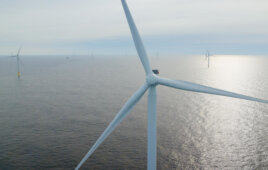Southwest Power Pool (SPP) set a wind-penetration record of 52.1% on February 12, becoming the first regional transmission organization (RTO) in North America to serve more than 50% of its load at a given time with wind energy.
Wind penetration is a measure of the amount of total load served by wind at a given time. The milestone beats a previous North American RTO record of 49.2% that SPP set April 24, 2016.

Wind penetration is a measure of the amount of total load served by wind at a given time, depending on weather conditions. Here wind is at 29%, but on February 12, it broke records at 52% penetration.
The proliferation of wind power in the SPP region has grown significantly over the last decade. As recently as the early 2000s, SPP’s generating fleet included less than 400 MW of wind, and for years, wind was reported in the “other” category in SPP’s fuel mix data.
Wind is now the third most-prevalent fuel source in the SPP region. It made up approximately 15% of the organization’s generating capacity in 2016, behind only natural gas and coal.
Installed wind-generation capacity increased in 2016 alone by more than 30% — up 4,000 MW from 12 GW to more than 16 GW. SPP’s maximum simultaneous wind generation peak rose from 9,948 MW in 2015 to 12,336 MW in early 2016.
“Ten years ago, we thought hitting even a 25% wind-penetration level would be extremely challenging, and any more than that would pose serious threats to reliability,” SPP Vice President of Operations Bruce Rew said. “Since then, we’ve gained experience and implemented new policies and procedures.”
Rew added: “Now we have the ability to reliably manage greater than 50% wind penetration. It’s not even our ceiling. We continue to study even higher levels of renewable, variable generation as part of our plans to maintain a reliable and economic grid of the future.”
The successful deployment of wind and other renewables in SPP is made possible because of its geographic diversity and robust transmission system. The RTO’s footprint covers almost 550,000 square miles from the Canadian border in Montana and North Dakota in the north to parts of New Mexico, Texas, and Louisiana in the south.
“We’re able to manage wind generation more effectively than other, smaller systems can because we’ve got a huge pool of resources to draw from,” Rew said. “With a footprint as broad as ours, even if the wind stops blowing in the upper Great Plains, we can deploy resources waiting in the Midwest and Southwest to make up any sudden deficits.”
SPP has approved the construction of more than 10 billion dollars in high-voltage transmission infrastructure over the last decade, with much of it being built in the Midwest to connect rural, isolated wind farms to population centers hundreds of miles away.
“It’s exciting to see the evolution of our efforts to maintain a reliable power grid,” SPP President and CEO Nick Brown said. “It allows for very different generation patterns than we’ve historically experienced. But for new day-ahead unit commitment procedures and market processes for managing congestion across a single balancing authority in fourteen states, these new records would not be possible.”
Filed Under: Projects




